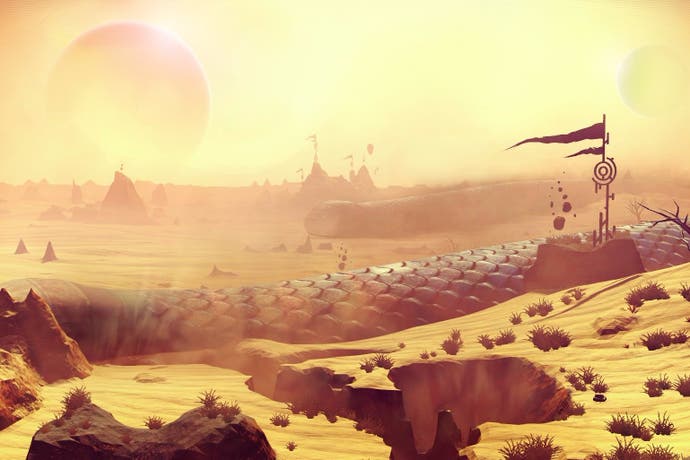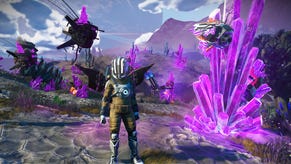Face-Off: No Man's Sky
PlayStation 4 takes on budget and mainstream gaming PCs.
It's pretty obvious by this point that No Man's Sky has several clear advantages on PC over its PS4 stablemate. In the best case, it gets an expected push from 30fps to 60fps (and beyond), a vastly widened field of view, plus a clearer 16x anisotropic filtering pass for textures - with a bit of fiddling. With a slight reduction to terrain pop-in too, it's undoubtedly a better-looking game, though perhaps not the radical improvement PC gamers might have hoped for.
It's not all plain sailing though. Stuttering frame-rates and even crashes, are still a problem on certain setups. However, PC offers some enhancements to sweeten the deal, and while differences in shadow and texture quality are moot, the advances in overall presentation stand out. For example, tweaking the field of view slider from the default 75 value (as used on PS4) to 100 helps remove a very restrictive cone of vision. Going one further, editing the game's .ini file in the game's Steam directory lets us push this out to 140 - maximising that periphery, at the expense of introducing a fishbowl effect.
Texture filtering also gets a noticeable boost, with the right tweaks. Sadly, even with the arrival of the latest patch, the in-game setting doesn't show much of a difference between 2x and 16x settings right now - a blurry implementation regardless of what you choose, and one that matches PS4 closely. The good news is you can force the issue with your GPU's control panel; for example, Nvidia users can override the game's setting with its own 16x anisotropic filtering. This gets great results, and textures appear far cleaner at tight angles than the stock PC or PS4 settings.
Otherwise, visual gains are surprisingly limited. The texture filtering tweak is well worth it, but can't address the inherently low-res, soup-like nature of most of the title's texture maps. In fairness, this is part and parcel of the game's procedural approach to creating each planet, and likewise, the PC's best terrain generation setting doesn't fully hide No Man's Sky's pop-in while boosting across a planet. We get a small margin of improvement over PS4's draw distances, which has objects materialise closer to the camera, but it's far from refined in motion.
In other words: if you go with PC, don't expect a vast upgrade over console visuals - just some neat bonuses, though some might say that the requisite boost to frame-rates and resolution offer enough of an upgrade to make the PC experience more preferable. Thankfully, the 4x SSAA option now works properly with PC's PC's latest patch, which uses a super-sampling technique to reduce the pixel crawl seen with FXAA (notably around space station hangars). The SSAA approach is far more effective, but as the only in-game alternative to FXAA, it's also incredibly taxing on any GPU. Only the absolute best-in-class graphics cards like the Pascal-based GTX Titan X can enable this - or push up to 4K resolution - and still sustain 60fps.
And this leads us on to No Man's Sky's performance on PC, and how a more down-to-earth selection of cards fare with it. Our first port of call is a test of the successors to mainstream champions GTX 970 and R9 390 - the GTX 1060 and RX 480. Both cards are updated to their latest drivers we had available: version 372.54 for Nvidia, and AMD's hotfix driver 16.8.2. We also used the latest patch, a version that brings a number of tweaks to the game, including optimisations for CPUs with fewer threads, a fix to a shader caching issue that caused some stutter, and much more.
The performance stats speak for themselves. Both the GTX 1060 and RX 480 are tested at 1080p resolution and FXAA, with maximum settings across the board otherwise. The GTX 1060 offers a clear lead here, with a circa 20fps advantage compared to the RX 480 while on foot. Even stress-testing the title by flying over terrain shows this same divide between the cards, but crucially, it's the GTX 1060 that still manages to run at 60fps and above in this scenario, and it's very rare to see it drop below that line. Meanwhile the RX 480 has a clear difficulty by comparison, with dips to around 45fps coupled with aggressive frame-time stutters as low as 50ms.
In terms of averages, it means the GTX 1060 rounds out at 75fps overall - across a mixture of walking and intensive flying - while the RX 480 averages at 55fps. That's a 36 per cent advantage in favour of Nvidia, and certainly not in line with the more expected differential between these cards. It is worth noting that Nvidia has benefited significantly from a 'game-ready' driver that appeared some days after the game's launch. At the time of writing, there's no such AMD equivalent.
So as things stand, it means max settings at 60fps is off the table for the AMD card, especially with the distracting frame-time stutter. This is despite our test RX 480 model being better-equipped with 8GB RAM, next to the 6GB on the GTX 1060. It appears memory isn't an issue on either side though, and the cause of this divided performance may instead lie with No Man's Sky use of OpenGL - an API that's caused issues for AMD cards in the past.
It's a clear-cut case in favour of the GTX 1060 - and equally, our i7 4790K holds up well too with the game's terrain streaming, where at peak load the CPU only rises to 50 per cent usage per thread. There's no apparent bottleneck on this side, and it does help pinpoint AMD's driver support for OpenGL titles as the issue here.
Moving on, for our next run of tests we downsize to a more budget-orientated setup. This focuses on a Core i3 4130 processor, this time paired with a GTX 950 with 2GB of VRAM, as compared to an RX 460 with 4GB. The goal is shifted to medium settings at 1080p resolution for this duo, while still forcing 16x anisotropic filtering in each GPU's control panel. Even with this visual hit however, neither card hits 60fps - but really we're just looking for console-equivalent performance.
Across a similar range of matched tests (on foot and airborne), the GTX 950 turns in a 48fps average, compared to 36fps on the RX 460. The turnout while scavenging for resources is impressive on Nvidia's card, and at this medium setting we can get between 50-60fps, with the AMD card typically at 10fps lower. Even the i3 processor holds up nicely while in this scenario; all four threads operate at around 50 per cent capacity.
But of course, this all changes when we take to the skies. Whether it's down to the game's procedural terrain generation, or simply a much expanded draw call rate, all i3 CPU threads shoot up to 100 per cent usage here, and with the RX 460 installed, the game suffers from heavy stuttering at 90ms and higher. It's a very choppy experience here, and shows the game's optimisation - or perhaps the AMD driver - needs fine-tuning for Radeon cards. On the other hand, the GTX 950 stays above the 30fps line throughout with no major frame-time issues.
For Nvidia's card, this translates to a feasible 30fps experience if you were to cap it at that rate. Half-rate adaptive v-sync would lock you to 30fps and leave enough GPU overhead to increase some settings. The results on RX 460 are less encouraging though, as prone as it is to some drops below this number, with stuttering pushing it below 20fps at points. We've seen plenty of patches to the game already, even within the first week, and there's a chance there's improvements to come for AMD users, but right now, the results show No Man's Sky is simply a smoother experience with Nvidia cards.
We're hopeful for an AMD update to address this, much like the one we saw arrive for our initial Doom GTX 970 vs R9 390 tests - another OpenGl title that suffered from markedly worse performance from the red corner at first. In that case, a new driver arrived from AMD within hours of publishing our analysis (we have the worst luck sometimes) to put the R9 390 in the same performance ballpark. For the sake of No Man's Sky's many PC players, perhaps using a less capable CPU, we hope history is repeated here.


















